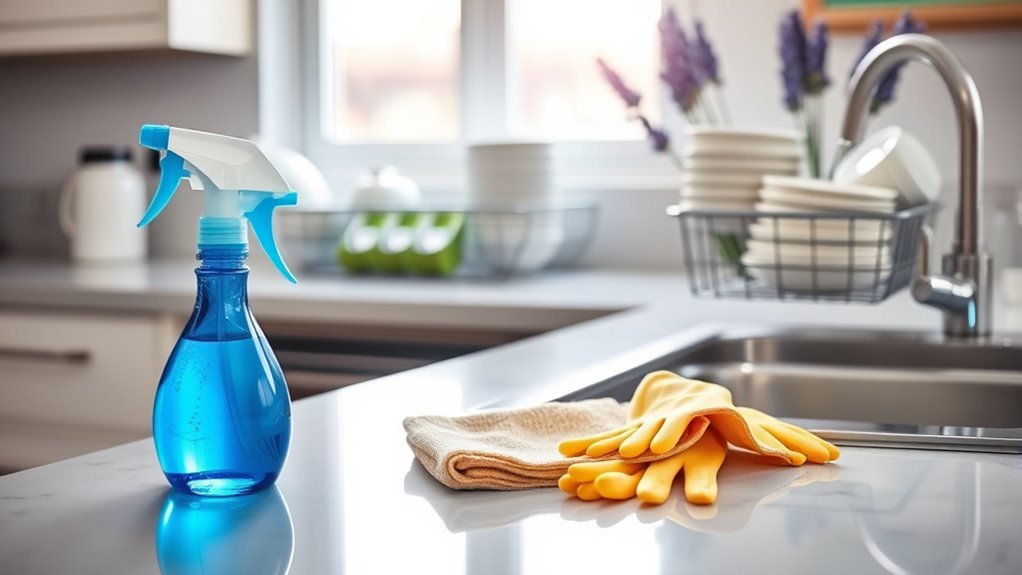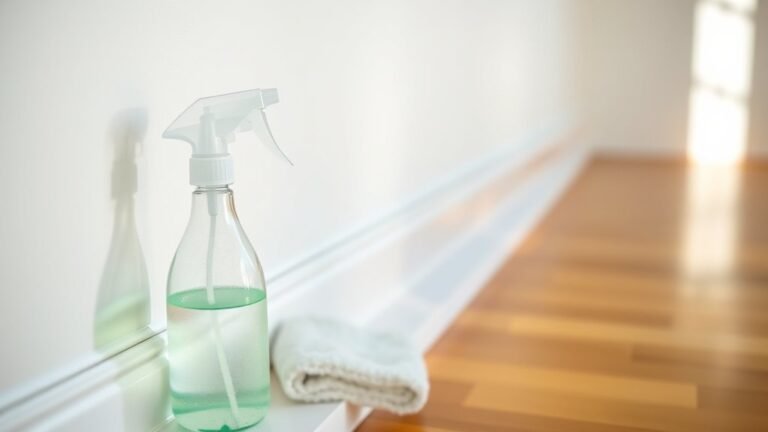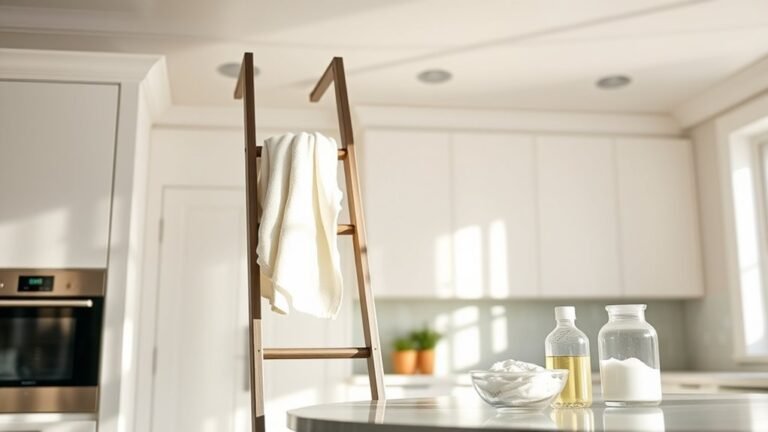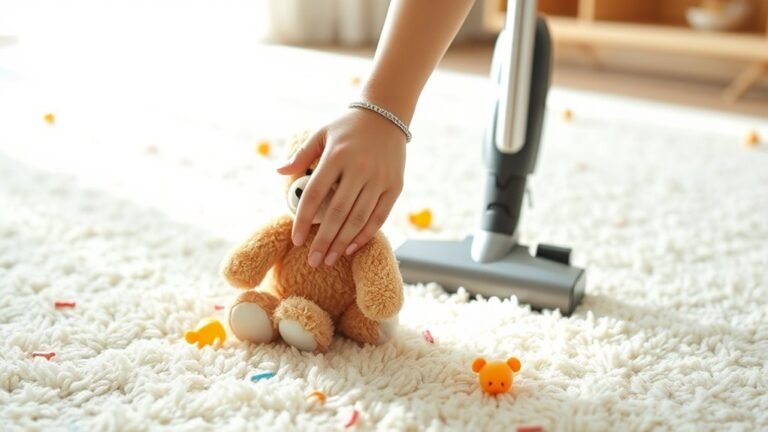How to Clean Your Home After Germs
After germs have been in your home, start by targeting high-touch areas like doorknobs, light switches, and faucets using EPA-approved disinfectants. Prepare your cleaning supplies, including gloves and microfiber cloths, and remove clutter for thorough access. Disinfect surfaces carefully, following product instructions to guarantee effectiveness. Don’t forget to launder bedding and soft fabrics in hot water, and maintain good ventilation to reduce airborne germs. Keep going to discover essential tips for kitchen and bathroom sanitation and air quality improvement.
Identify High-Touch Areas to Prioritize
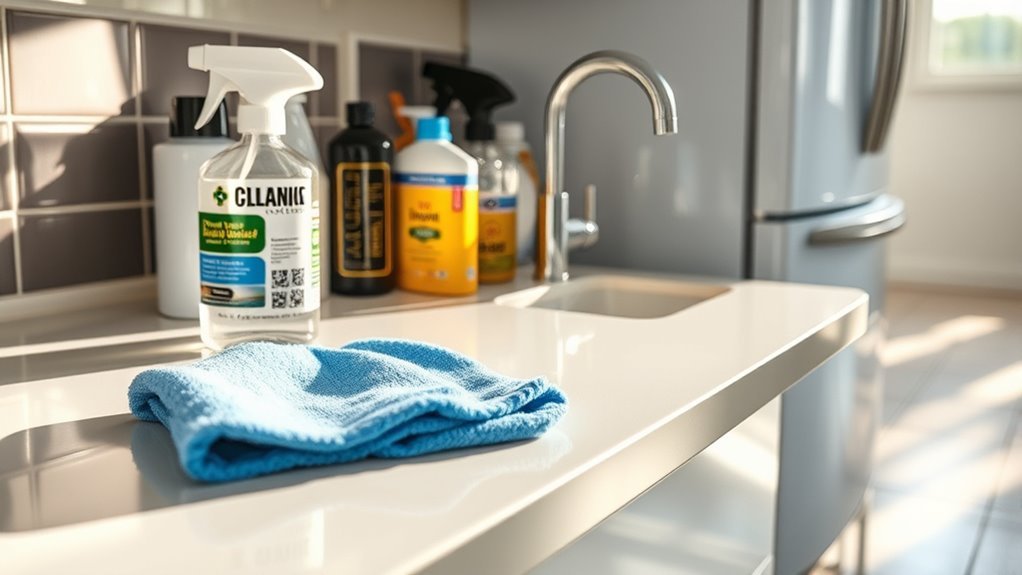
When cleaning your home after exposure to germs, start by identifying the top high-touch areas that need the most attention. These surfaces—like doorknobs, light switches, faucet handles, and remote controls—are hotspots for germ transmission. Evidence shows that frequent cleaning of these high touch surfaces notably reduces the risk of infection. You should focus on areas you and others touch multiple times daily. Prioritize kitchens and bathrooms, as these spaces naturally harbor more bacteria. Don’t forget shared electronics and common furniture arms. By targeting these key spots with consistent cleaning, you regain control over your environment and protect your health. Remember, maintaining freedom means taking proactive steps, and frequent cleaning of high-touch surfaces is a practical, effective way to keep germs at bay.
Choose the Right Cleaning Products
Although there are many cleaning products available, choosing the right ones is crucial for effectively eliminating germs without damaging surfaces or harming your health. You want products that balance disinfectant effectiveness with safety and sustainability. Here’s how to select wisely:
Choosing cleaning products that effectively kill germs while protecting surfaces and health is essential for safe, sustainable sanitation.
- Look for EPA-registered disinfectants proven to kill a broad spectrum of germs.
- Consider eco friendly options that use biodegradable ingredients and reduce chemical exposure.
- Avoid harsh chemicals like ammonia or bleach on delicate surfaces to prevent damage.
- Check product labels for recommended contact time to guarantee germs are fully eliminated.
Prepare Your Cleaning Supplies

Before you start cleaning, gather essential tools like microfiber cloths, scrub brushes, and a mop to guarantee thorough coverage. Choose disinfectants proven to kill germs effectively, such as those containing bleach or alcohol. Don’t forget to prepare protective gear like gloves and masks to keep yourself safe during the process.
Essential Cleaning Tools
A well-stocked cleaning kit is essential for effectively tackling germs in your home. Having the right cleaning tools not only improves germ prevention but also makes your efforts more efficient. Here are four must-have items to include:
- Microfiber Cloths: These trap dirt and microbes better than traditional cloths without spreading germs.
- Scrub Brushes: Essential for cleaning grout and textured surfaces where germs hide.
- Disposable Gloves: Protect your hands and reduce cross-contamination.
- Spray Bottles: Useful for applying water or cleaning solutions evenly.
Effective Disinfectants Selection
Choosing the right disinfectants is essential for effectively eliminating germs and preventing illness in your home. You want options that balance power and safety, especially if you lean toward natural disinfectant alternatives. Understanding an effective germicides comparison helps you pick what fits your lifestyle and cleaning needs.
| Disinfectant Type | Pros | Cons |
|---|---|---|
| Bleach (Sodium hypochlorite) | Strong, fast-acting | Harsh fumes, skin irritation |
| Alcohol-based (70%+) | Quick drying, broad spectrum | Flammable, can dry skin |
| Natural alternatives | Safer, eco-friendly | May need longer contact time |
Use this table to guide your selection, ensuring you prepare your cleaning supplies confidently.
Protective Gear Preparation
Once you’ve selected the right disinfectants, it’s important to equip yourself with proper protective gear to avoid exposure to harmful chemicals and germs. Prioritize gloves selection by choosing durable, chemical-resistant gloves to protect your skin. Mask importance can’t be overstated; wear a well-fitting mask to prevent inhaling airborne pathogens or fumes. Additionally, consider eye protection to shield your eyes from splashes. Finally, wear long sleeves and pants to minimize skin exposure.
Here’s a quick checklist for your protective gear:
- Chemical-resistant gloves for effective gloves selection
- A properly fitted mask to guarantee mask importance
- Safety goggles or glasses to protect your eyes
- Protective clothing covering arms and legs
This gear guards your freedom by keeping you safe while cleaning efficiently.
Remove Clutter Before Cleaning

Before you start cleaning, it’s important to remove clutter from your space to guarantee that every surface can be properly disinfected. Using effective decluttering strategies helps you clear areas quickly and efficiently. Organizing tips like sorting items into keep, donate, or discard piles can minimize distractions and speed up the process. This step assures you won’t miss spots that harbor germs.
| Decluttering Strategies | Organizing Tips | Benefits |
|---|---|---|
| Sort by category | Use labeled bins | Faster cleaning |
| Remove unnecessary items | Prioritize high-touch zones | Better surface access |
| Maintain daily habits | Create dedicated spaces | Reduces germ hiding spots |
Disinfect Surfaces Thoroughly
Although removing clutter sets the stage, disinfecting surfaces thoroughly is essential to eliminate germs effectively. You’ll want to adapt your disinfecting techniques depending on the surface materials to guarantee safety and efficacy. Here’s how to proceed:
- Identify high-touch areas like doorknobs, light switches, and countertops.
- Choose EPA-approved disinfectants suited for each surface material—wood, metal, glass, or plastic.
- Follow product instructions carefully, allowing the disinfectant to remain wet on surfaces for the recommended contact time to kill germs.
- Use clean cloths or disposable wipes to avoid cross-contamination, replacing them frequently.
Launder Bedding and Soft Fabrics
Because germs can easily embed themselves in bedding and soft fabrics, it’s important to launder these items regularly and properly. Maintaining bedding hygiene not only reduces illness risk but also promotes a healthier living space. Use hot water when possible and a suitable detergent to kill germs effectively. Pay attention to fabric care labels to avoid damage.
| Task | Recommendation |
|---|---|
| Wash Temperature | Hot water (130°F/54°C+) |
| Detergent Type | Antibacterial detergent |
| Drying Method | High heat or sunlight |
| Frequency | Weekly or after illness |
Clean and Sanitize Kitchen and Bathroom
When cleaning your kitchen and bathroom, focus on disinfecting high-touch surfaces like countertops, faucets, and doorknobs using EPA-approved products. Make sure to follow the instructions on cleaning labels to guarantee both effectiveness and safety. Using the right disinfectants will help you eliminate germs without harming your surfaces or your health.
Effective Surface Disinfection
A crucial step in eliminating germs from your home is effectively disinfecting surfaces, especially in the kitchen and bathroom where bacteria thrive. Different surface types require specific disinfecting techniques to guarantee thorough germ removal without damage.
- Identify surface materials—like granite, stainless steel, or ceramic—to choose appropriate disinfectants.
- Clean surfaces first to remove dirt and grime, allowing disinfectants to work effectively.
- Apply disinfectants evenly, following manufacturer guidelines for contact time to maximize germ kill.
- Focus on high-touch areas such as faucets, countertops, and handles, which harbor the most bacteria.
Safe Cleaning Products Usage
While selecting cleaning products for your kitchen and bathroom, it’s important to prioritize those proven safe and effective for both germ removal and surface protection. Choose eco friendly options that minimize harmful chemicals, reducing your exposure and environmental impact. Look for products labeled as EPA-approved or those containing active ingredients like hydrogen peroxide or ethanol, which effectively sanitize without harsh residues. Always follow manufacturer instructions to guarantee chemical safety—never mix products, as this can create dangerous fumes. Use gloves and ventilate the area to protect yourself further. By selecting the right products and applying them correctly, you maintain a clean, germ-free environment while preserving your freedom from toxic substances. This balanced approach safeguards your health and promotes responsible home care.
Maintain Air Quality and Ventilation
Since germs can linger in the air even after surface cleaning, you should prioritize maintaining good air quality and ventilation in your home. Proper ventilation techniques help dilute airborne contaminants and reduce infection risk. Here’s how you can enhance your indoor air:
- Open windows and doors regularly to promote natural airflow.
- Use exhaust fans in kitchens and bathrooms to expel stale air.
- Invest in air purifiers—evidence shows their benefits in capturing airborne germs and allergens.
- Avoid overcrowding rooms, allowing air to circulate freely.
Frequently Asked Questions
How Long Do Germs Survive on Different Surfaces?
You might wonder about germ lifespan on various surface materials. Germs can survive from a few hours to several days depending on the surface. For example, on hard, non-porous surfaces like stainless steel or plastic, germs often live up to 72 hours. On porous materials like fabric or paper, their lifespan shortens to a few hours. Knowing this helps you decide when and how often to clean, giving you control over your environment.
Can Essential Oils Be Used as Disinfectants?
Imagine you’re freshening up your kitchen and wonder if essential oils can really kill germs. Yes, some essential oils like tea tree and eucalyptus act as natural disinfectants with antimicrobial properties. However, they’re not as potent as commercial cleaners and should be used alongside proper cleaning methods. If you want a chemical-free option, dilute essential oils in water and spray surfaces, but don’t rely solely on them for thorough disinfection.
Is It Safe to Use Bleach Around Pets?
When using bleach around pets, you need to prioritize bleach safety to protect pet health. Bleach can be toxic if ingested or inhaled, so always dilute it properly and guarantee good ventilation. Keep pets away from treated areas until completely dry to avoid exposure. Never mix bleach with ammonia or other cleaners, as fumes can be harmful. By following these steps, you can keep your home clean without compromising your pet’s well-being.
How Often Should Air Filters Be Changed?
Keeping your air filters in tip-top shape is like giving your home a refreshing sense of liberty. For peak air filter maintenance and to guarantee good indoor air quality, you should change standard filters every 90 days. However, if you’ve got pets, allergies, or a dust-prone environment, swapping them out every 30 to 60 days is wise. Staying on schedule not only boosts your health but also keeps your HVAC system running smoothly.
What Temperature Kills Most Household Germs?
You’ll want to use hot water at least 140°F (60°C) to kill most household germs effectively. When disinfecting laundry, this temperature helps eliminate bacteria and viruses, ensuring your clothes are safe and clean. Keep in mind, not all fabrics tolerate high heat, so always check care labels. Using hot water combined with appropriate detergents gives you the freedom to maintain a healthier environment without relying solely on chemicals.
